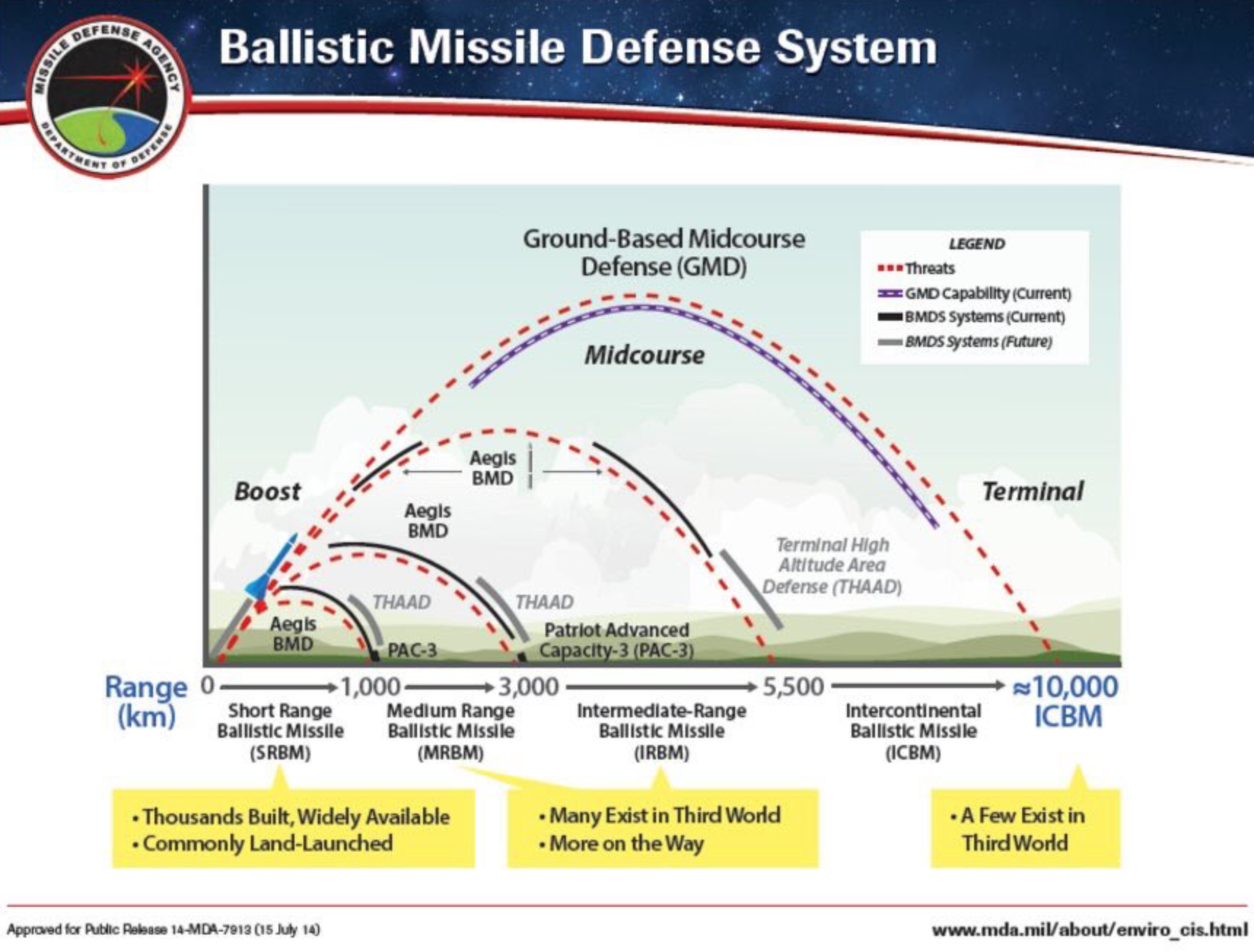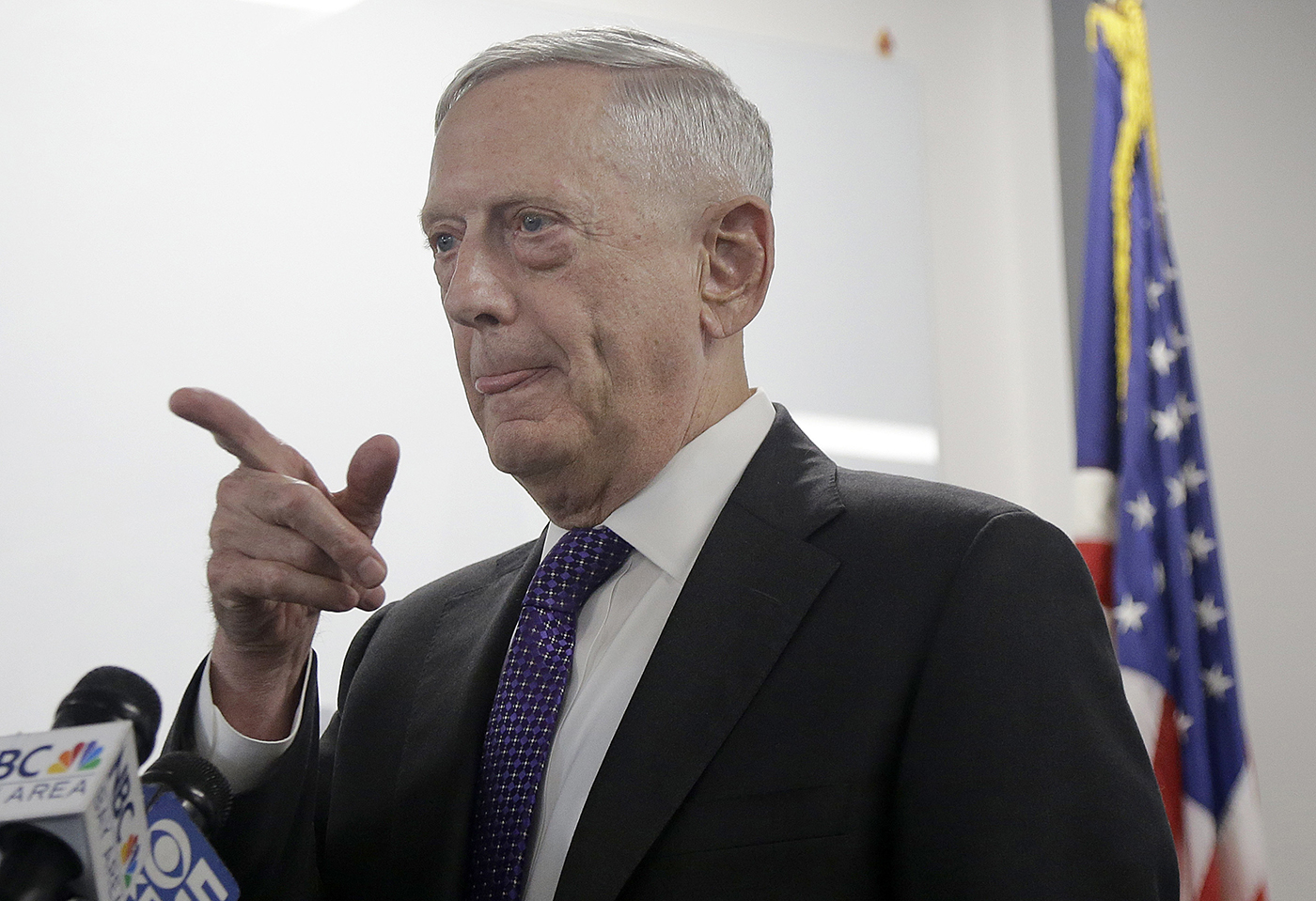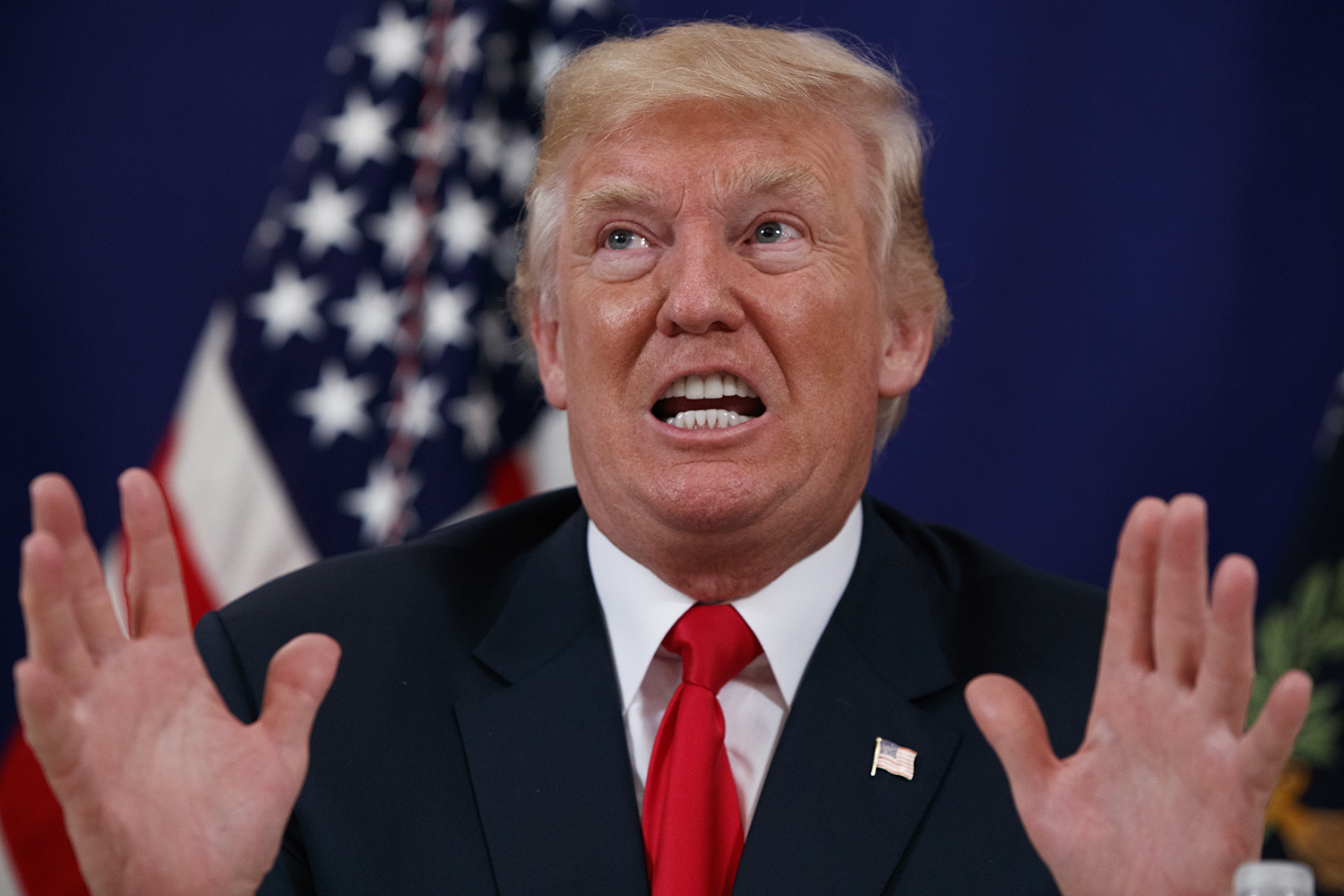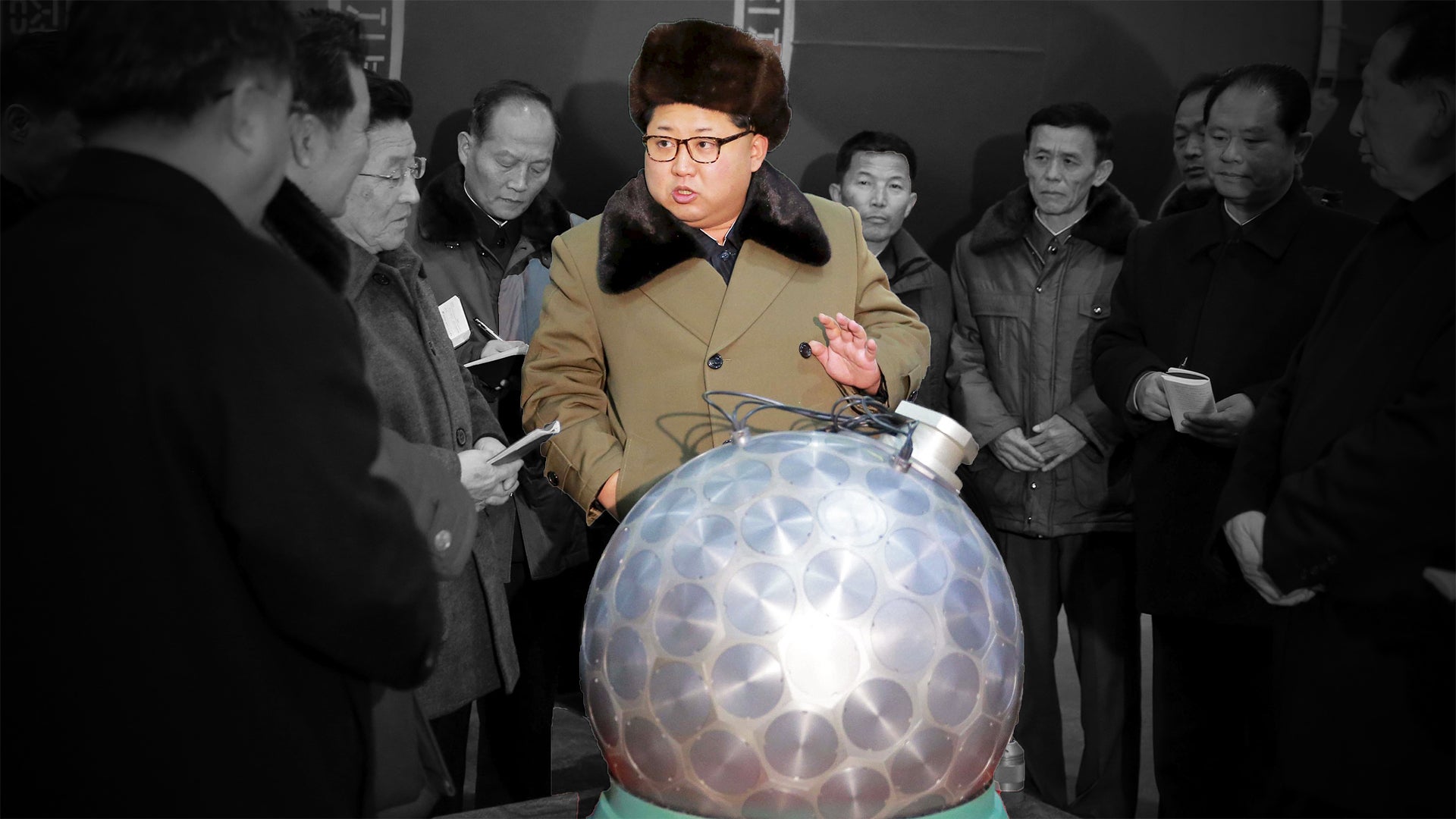A storm of North Korean hysteria hit the US this week, and with it have come story after story that allude to the specter of a war and even nuclear exchange. People are worried that war is coming, and rightfully so. But the strange thing about it is that this new phase in the North Korean standoff was largely born out of nothing—at least nothing in material. Instead it was largely fabricated by the President if the United States himself.
For all intents of and purposes, things are the same this week as they were last week when it comes to North Korea’s nuclear and missile programs. What has occurred was an alarming “off-the-cuff” moment by President Trump and the “leaking” of a report that just affirmed what was largely already a given—that North Korea has a miniaturized nuclear warhead design—something they have outright claimed over and over and has been assumed to be the case in most national security circles. In essence, this new hyper-volatile phase of the standoff with North Korea was built on messaging alone—in other words bullshit—and the media has only perpetuated this pseudo-reality.
The rhetorical shot heard around the world
So our Commander In Chief, who loves to just play it by ear, made his now infamous cross-armed statement from his Bedminster Golf Club in New Jersey on Tuesday, stating:
“North Korea best not make any more threats to the United States… He has been very threatening beyond a normal state, and as I said, they will be met with fire and fury and, frankly, power, the likes of which this world has never seen before.”
What a stupid, short sighted, and downright reckless thing to say considering what’s at risk. In fact, using rhetoric like “fire and fury” make it sound like Trump and Kim deserve each other and it lowers the bar once again in regards to what’s expected from the historically steady hand and calming tone of the American Presidency. It’s tough guy talk for tough guy talk’s sake, and it plays right into the hand of Kim Jong Un’s paranoid notions, propaganda machine and adversarial view of the US and its allies. Above all else, it is trolling for escalation and for a response from the North Korean regime. And that is exactly what we got.
Some have attempted to fill in the strategic cracks left by Trump’s belligerent statement by claiming it was a protracted play to speak in terms similar to those used by Kim Jong Un. Basically an attempt to speak in Kim’s “own language” which is an oxymoron in itself. This is a sorry attempt by the Trump’s ever-present peripheral messaging machine to retcon his improvisational and often reckless use of words.
In reality, it has become abundantly clear that everyone in the Washington security apparatus was taken off-guard by the ominous remark. So no, there was no grand strategy behind the statement, just Trump doing what he does. Which may be entertaining and even strangely refreshing to some, but those same people are sadly going to learn that it’s actually a high-risk, low reward personal tick, not an effective new way of conducting foreign policy from one’s hip. And it is one that is likely to get this country and its allies in a lot of trouble.
Major changes in strategy and messaging regarding what could turn into a horrendous war should be carefully planned and addressed to the country in a formal setting, where the message can be fully explained and fleshed out. Otherwise Americans, our allies, and the enemy are left to fill in the blanks. Instead we get some soundbite from what looked like a luncheon at a golf resort. This is alarming to say the least and puts in doubt Trump’s ability to handle a rapidly developing high-stakes crisis not if, but when one actually occurs.
Once again, this was all spurred supposedly by a classified intel report that stated something that was already more or less a given in national security circles—that North Korean scientists have built a nuclear warhead capable of riding in a missile. Of course this warhead has not been tested—both in the ground or on an actual missile. So all Trump’s outrage is really over nothing new. In essence, it is a fabrication.

Trump came out again on Thursday and double downed on his earlier “fire and fury” statement. This is not a surprise as he always does this, regardless of the reaction or its negative impacts. He also went on to use his same ambiguous line “we’ll see what happens” when it comes to a possible preemptive strike on North Korea and what comes next in standoff. He also said seemed to think negotiations were futile, but said he likes to talk. See the exchange below.
“The people who were questioning that statement, ‘was it too tough,’ maybe it wasn’t tough enough. They have been doing this to our country for a long time, for many years. It us about time someone stuck up for the people of other countries. So, if anything, maybe that statement wasn’t tough enough and we are backed by 100% by our military, we are backed by everybody and we are backed by many other leaders.”

The President also tweeted claims regarding America’s nuclear arsenal, which were a flat out lie—or even worse—a delusion, stating:
“My first order as President was to renovate and modernize our nuclear arsenal. It is now far stronger and more powerful than ever before…. Hopefully we will never have to use this power, but there will never be a time that we are not the most powerful nation in the world!”
No, that was not his first order as President, and really there has been no change between the modernization plans under President Obama and those under President Trump, aside from an ongoing nuclear posture review and Trump simply telling the DoD to make sure they are ready to execute a nuclear attack if he orders one. So once again, this was either a lie or a figment of his imagination. Either way it is unacceptable, and for a guy that talked loosely about the use and proliferation of nuclear weapons constantly during his campaign, while not even knowing what the nuclear triad is, more big talk about nukes sure isn’t encouraging. Also, this same man now resides no more than a couple dozen feet away from the nuclear football at all times and carries a nuclear biscuit containing the gold codes to use it in his pocket, and there isn’t really anyone who could stop him from doing so.
Really, who is he talking to with messages like this? His base who wants a strongman in office or the enemy? If it’s the former, does he really think North Korea’s military intelligence isn’t aware of America’s nuclear capabilities? Frankly, it’s moronic.
The media fans Trump’s ‘fire and fury’ flames
Shortly after Trump’s tough talk came North Korea’s nerve rattling response, which (surprise!, surprise!) wasn’t “yes Mr. Trump we have seen the error in our ways now that you have threatened us with hyperbolic tyrant language.” Instead the North Koreans brushed Trump’s bluster aside and said they will now put together a plan to demonstrate their downrange ballistic missile attack capability by launching intermediate-range ballistic missiles towards Guam. The mainstream media jumped on this and declared that North Korea was finalizing its attack plans on Guam. That simply wasn’t the case. Once again, Pyongyang threatened to demonstrate their abilities, not execute an actual strike, with their statement saying that the country would launch four Hwasong-12 missiles and that they would land 30-40km off the coast of Guam as a show of force if Kim ordered the execution of the plan in development.
So no, North Korea isn’t threatening to strike Guam directly, they are threatening to make a grand display proving that they could if they wanted to. Also, as we have stated many times, Guam has been equipped with a Terminal High Altitude Air Defense (THAAD) battery since 2013, a unit adeptly named the “Musudan Manglers,” that is capable of fending off low-volume intermediate-range ballistic missile attacks. Aegis missile defense equipped surface combatants could also potentially shoot these missiles down during their mid-course phase of flight, and seeing as they would have to fly over Japanese territory to get to Guam, there would be a good reason for doing so.

But it is worth underlining America’s missile defense systems do not equal a missile shield. They still lack extensive real-world testing and some rely on a rickety network of communications and sensor systems in order to be effective.
Clearly even just an inert display of ballistic missile capability would be regarded as a huge escalation and would rattle nerves in Guam and in the region overall. But still, a show of force test where the ocean is the intended target is a far cry from an actual attack. The real risk is in how the launch is initially interpreted. If it is perceived as a strike against Guam, the gears of war could already be turning with great momentum by the time the missiles arrive at their intended target. Also, do we really think North Korea doesn’t already have plans to attack Guam in place? So how is this new? Guam is the primary target for their intermediate-range ballistic missiles, which they have spent countless resources on developing.
When you look at the situation through a wide angle lens, it is clear that all the latest escalation has been is largely spun up by the Trump administration and the media who seem more than willing to play along without digging into the details. And hey, it’s no secret that threatening headlines get eyeballs.
Most the cable show military experts also seem to be all too willing to play along with the most threatening interpretation of recent events—or they simply haven’t done their own research on the issue and rely on highly outdated information and inaccurate assumptions for analysis. This is no real surprise either as cable news military pundits have proven to be the most chronically inaccurate sources of information on defense topics, and especially when it comes to technological capabilities of various weapon systems.
Maybe one of the best instances of the press blindly buying into the North Korean hype are how they publicize B-1B bomber’s intimidation/propaganda training missions near the Korean DMZ. First off, there are always bombers forward deployed to Andersen AFB on Guam, their presence there is not a result of heightened tensions with North Korea. Second, no, for the hundredth time the B-1B is not a nuclear capable platform and it is not practicing for nuclear strikes on North Korea. Third, these flights have been occurring regularly over the last year, and similar flights have occurred like clockwork for over a decade, always after North Korea executes a provocative act.
Finally, the B-1B is not going to gallantly waltz into North Korea and hit a series of targets around the country as part of a targeted preemptive strike against Pyongyang’s nuclear and missile programs. And it definitely is not going to lead off a protracted air war over the country either. At best it would launch a series of cruise missiles from outside North Korean borders against lightly fortified targets, that is until corridors through North Korea’s air defenses have been opened up, or it would attack artillery positions along the DMZ. North Korea’s air defenses may not be advanced, although that too is changing to some degree, but they are dense and some of their systems are of the unpredictable road-mobile variety.
Even with electronic warfare support and its low-altitude penetration capabilities, the B-1 is still vulnerable. Stealthy or expendable assets, such as the B-2, F-22 and cruise missiles, would initiate strikes, followed eventually by F-16CJs Wild Weasels and strike fighters to begin wiping up non-fixed surface-to-air missile and other integrated air defense system targets. All this will be supported by the full array of America’s space-based surveillance and cyber warfare capabilities.

In other words, any action over North Korea short of blowing up a single missile on its launch stand or having B-2s and cruise missiles go after a small set of targets would require large packages of assets. NBC reports there is a plan in place for a series of strikes directly related to North Korea’s missile and nuclear programs, but once again, this would not be executed directly by the B-1s, but they could help by adding air-launched cruise missiles to the mix:
“The target set, multiple sources say, would be approximately two dozen North Korean missile-launch sites, testing grounds and support facilities. The sources told NBC News they feel confident they have accurately identified a set of relevant targets.”
Really, the B-2, with its stealth design and Massive Ordnance Penetrator carrying capabilities would be needed to go after some of these targets, being that they are buried deep below mountains in fortified bunkers and outside the reach of normal “bunker buster” munitions carried by other aircraft.
So by and large, this latest North Korean missile hysteria is largely manufactured through headline grabbing but outlandish messaging by Donald Trump. The media frenzy that has followed, ranging from stories stating that North Korea is going to attack Guam to the B-1B’s misunderstood training missions, is just a byproduct of that messaging. And don’t mistake tough guy talk for a new strategy, far from it in fact. We still haven’t seen any concrete changes in the way the issue is being dealt with under the Trump Administration, and we already have experienced one round of “looming attack” false bluster by the White House that ended up going nowhere.
Neither side wants a fight
Here’s the cold hard truth: The last thing North Korea wants to do is attack its neighbors and especially the United States. The same thing can be said for the US and its allies attacking North Korea. Any sort of conflict with North Korea will lead to an immediate negative outcome no matter how well the initial military action goes. Economies will crash and a regional Pandora’s box will be opened with countries acting in their own self interest militarily, with China being the ultimate wildcard. Above all else, the scale of death and destruction would likely be unprecedented, at least in the last half century of the planet’s history.
For Pyongyang and the Kim regime the stakes are even higher, as there is no way they would succeed in a military conflict with the US. But that doesn’t mean the toll such a war would take wouldn’t be massive and last for at least a generation.
Regime change in North Korea has been floated as a plausible goal of the administration since Trump took office. In reality, that is a miserable idea, and executing such a plan, through a decapitation strike or otherwise, would likely result in an outcome that would make the invasion of Iraq look like a day at the beach.
North Korea presents an especially unique military and social challenge. The country’s population is already near starving and has lived under a brainwashing military state apparatus all their lives. If you don’t think Iraq was ready for democracy, North Korea may as well be an alien planet. The Kim regime also has at least a dozen—more like two or three dozen—nuclear warheads at its disposal along with other heinous weaponry. Not just that, but North Korea has a massive, albeit technologically antiquated army that is socially programmed to see the US and its allies as sub-human and monstrous enemies. The thought of attempting regime change under such circumstances is a deranged hallucination at best. Just imagine what a North Korean occupation and provisional government would look like and how long it would have to endure. An entire population would have to be sustained and reprogrammed.

Although we may hate this fact, Kim Jong Un brings stability to a country that is not anywhere near prepared to enter the world community peacefully. Just the shock and disorganization brought on by taking out Kim Jong Un would likely lead to a huge refugee crisis, one that China will be on the receiving end. And the question of what, or more importantly who comes next is maybe the most important unknown of all.
Kim Jong Un has purged many of the established ruling class who had tight links with a few external powers, namely China. It is likely the person who replaces Kim will be just as bad if not worse than he is, and will now have to rule knowing the US and its allies are not just a historic enemy, but an active enemy that is willing to kill the country’s leadership on a whim. This plays into decades worth of propaganda, wild claims and the general narrative fed to the public by the Kim family and their henchmen. Then there is the possibility that nobody would replace Kim at all, and the country would fall into factional infighting and general chaos. For a nuclear armed state, this is the sum of all fears.
So once again, there is no attractive military solution when it comes to dealing with North Korea, and calling the country’s bluff by striking at its weapons programs would likely lead to a full scale war before the aircraft have even left North Korean airspace.
What’s most troubling is that the Trump administration says the only diplomatic solution will include disarmament of Kim’s nuclear and missile programs. Let me make this clear, he will never give up his pocket arsenal of nuclear weapons. The US has played right into the reasoning as to why he would never turn this arsenal over—it is a highly logical and effective deterrent that can keep a superpower that has surrounded you with superior conventional war fighting capabilities at bay. But without a vetted delivery system and warhead that arsenal is far less threatening than otherwise, which is the case for the time being.
Time for a diplomatic solution dwindles
With all this in mind, every minute we waste being unwilling to negotiate a deescalation deal that would include freezing Kim’s nuclear and missile programs, not eliminating them totally, the closer we come to the point where that won’t ever be an option. Once his deterrent is verified, even if he agrees to freeze it, he would still have the ability to threaten the US mainland and his neighbors with nuclear tipped missiles. Then what?
Basically, if a deal can’t be made before this milestone comes to pass—the successful testing of a miniaturized warhead and its delivery system including a survivable reentry vehicle to carry said warhead— there will likely be one of two outcomes. Either war will occur or we will have to live the fact that North Korea will able to reach the US with an ever improving and increasingly arsenal of missiles and nuclear warheads. The chances that Kim will sell his verified missile and warhead technology to anyone with cold hard cash is also a given.
These are the issues we should be discussing, not tough guy talk that games out in the same two outcomes, both of which are unimaginable. And once again, there would have been no escalation this week if President Trump hadn’t injected apocalyptic like language into the public sphere.

Some will applaud this type of talk as “getting tough” on North Korea. But words are cheap and Kim Jong Un knows that better than anyone. Those same people who Trump’s bluster is a good thing will probably feel differently if thousands of body bags start piling up on the Korean Peninsula—including those with US military personnel inside, and the world economy crumbles and takes the US economy with it.
Now the big question is where do we go from here? Trump, who claimed he would talk directly with North Korea before becoming President, is backing himself into a strategic corner and is dragging Kim Jong Un along with him. This is mainly because there is no path to exit the escalating situation being offered aside from total capitulation by the North Koreas. Disarm or we will do it for you is seemingly the ultimatum. So Kim will call Trump’s bluff, and the scary part about that is Trump will be compelled to act or look like a bag of hot air whose words mean nothing. And for a guy who seems to think everything is either huge or tiny, great or terrible, and the best or the worst, scalable reactions may elude him.
So there you have it, we are now in new phase of an increasingly volatile crisis, and this phase never had to occur. It is a fabricated escalation in rhetoric that guides both sides to the point of no return, and it is indicative of a strategy that seems to offer no clear and potentially acceptable path to deescalation.
Contact the author: Tyler@thedrive.com
